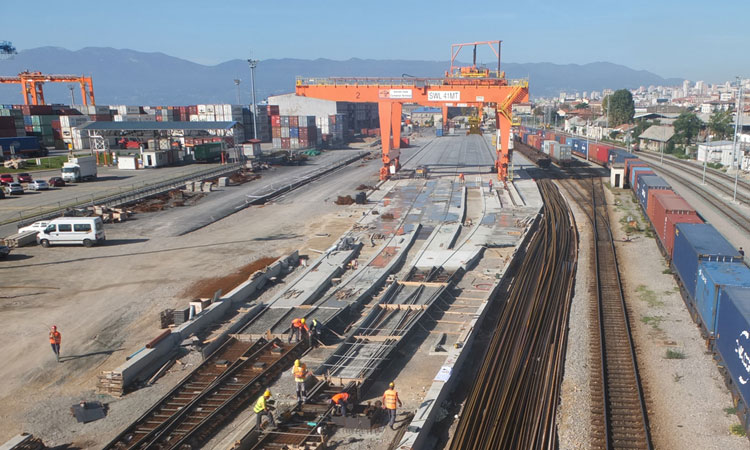Investing in infrastructure to rejuvenate Croatia’s railways
Posted: 27 November 2019 | Ivan Kršić | No comments yet
Croatia is currently experiencing the largest investment in railway infrastructure in the republic’s history. For Global Railway Review, Ivan Kršić, President of HŽ Infrastructure, explains the drive for investment as the company strives to modernise Croatia’s corridor routes which are so significant to its place within Europe.


HŽ Infrastructure is a 100 per cent state-owned company and the only railway infrastructure manager in the Republic of Croatia which maintains, modernises, and builds railway infrastructure and regulates railway traffic on behalf of and for the benefit of the owner, the Republic of Croatia. The company operates 2,605km of track with 531 stations and stops, 1,505 level crossings, 540 bridges and viaducts, and 109 tunnels. Of this number, 37 per cent are electrified and 10 per cent are double-track lines.
The Republic of Croatia is located on two corridors of the Core Transport Network – on the Mediterranean Corridor and on the Rhine-Danube Corridor. One of the key goals of HŽ Infrastructure is to modernise and renovate the rail network under its management, as well as the supporting infrastructure as much as possible. The focus is on modernising corridor routes with the financial support of the European Union (EU).
HŽ Infrastructure is a 100 per cent state-owned company and the only railway infrastructure manager in the Republic of Croatia which maintains, modernises, and builds railway infrastructure and regulates railway traffic on behalf of and for the benefit of the owner, the Republic of Croatia. The company operates 2,605km of track with 531 stations and stops, 1,505 level crossings, 540 bridges and viaducts, and 109 tunnels. Of this number, 37 per cent are electrified and 10 per cent are double-track lines.
The Republic of Croatia is located on two corridors of the Core Transport Network – on the Mediterranean Corridor and on the Rhine-Danube Corridor. One of the key goals of HŽ Infrastructure is to modernise and renovate the rail network under its management, as well as the supporting infrastructure as much as possible. The focus is on modernising corridor routes with the financial support of the European Union (EU).
Revitalising infrastructure
The ultimate goal of HŽ Infrastructure projects is to revitalise railway infrastructure in accordance with European standards, which will increase railway capacity, increase the speed of train operations to 160km/h, shorten journey times, and enhance the level of safety. We are currently working on 20 such projects in total, in various implementation stages, and it is important to mention that these are large and complex major projects, for which preparation and implementation has lasted for several years. Given the complexity and procedural requirements laid down by the EU, HŽ Infrastructure can say that these are all generational projects. The purpose of all investments is to improve and upgrade railway infrastructure in Croatia, aimed at achieving a greater railway sector traffic share by increasing the capacities and services on major transport corridors and regional railway infrastructure.
Currently, the works on the section from Dugo Selo to Križevci (a part of the Mediterranean Corridor) are in progress. This is currently our largest project, where the works in progress are worth almost €200 million. The first phase of the project was co-financed by the European Regional Development Fund (ERDF), which has provided 85 per cent of the project value from the Transport Operational Programme 2007-2013, with 15 per cent financed by national funds. The second phase is co-financed under the Operational Programme Competitiveness and Cohesion 2014-2020.
The Dugo Selo–Križevci project envisages the construction of the second track and reconstruction of the entire railway line section – 36.4km in length. The reconstruction of individual horizontal curves, track structures, and fixed electric traction installations will enable train operation at the designed speed of 160km/h along the entire length of the section. Stations will be reconstructed to receive 750m-long interoperable freight trains, and some also 400m-long interoperable passenger trains.
Upgrading Croatia’s freight connections
Works are also taking place at Rijeka Brajdica Station and Brajdica Container Terminal (a project worth €35.6 million) and at Zagreb Pier Container Terminal (a project worth €31.6 million). HŽ Infrastructure is implementing these two projects in partnership with the Port of Rijeka Authority. The geo-traffic position of the Port of Rijeka is very important. For example, the Suez–Rijeka waterway is six days shorter than the Suez–Rotterdam, Hamburg waterway. Transport of goods to Central Europe is taking place via the Port of Rijeka – the fastest and shortest route to Austria, Slovakia, Czech Republic, Hungary, and southern Germany.
HŽ Infrastructure is also working on the final actions on a project to construct a new railway line for suburban traffic on section Gradec–Sveti Ivan Žabno, worth €30.1 million. This project is also 85 per cent co-financed by the ERDF and Operational Programme Competitiveness and Cohesion 2014-2020, and the remaining 15 per cent by national funds. Once the new train timetable comes into force, planned by the end of 2019, this 12.2km-long section will be put into operation – the first entirely new railway line in the Republic of Croatia for 50 years. This project will considerably shorten journey times between Zagreb and Bjelovar as a regional centre.
Works have also been in progress on the 24km-long section from Zabok to Zaprešić (a project worth €80.8 million), a section important for suburban traffic for the city of Zagreb. This project receives 85 per cent of its finance from the Cohesion fund by means of the Operational Programme Competitiveness and Cohesion 2014-2020, and the remaining 15 per cent of project value is financed from national funds.
Linking the Iberian Peninsula
It is very important to mention the reconstruction of the existing track and construction of the second track on the 42.6km-long section Križevci–Koprivnica–state border (Hungary), where the eligible costs of the project are €283.9 million. The procurement process for this section has been in progress. Ten bids have been received and an evaluation is in progress. This huge project continues the modernisation of the Mediterranean Corridor, which links the Iberian Peninsula via the Port of Rijeka, Zagreb, and Budapest, with the Hungarian and Ukrainian border.
In the east, we have a project of modernisation and electrification of the 18.7km-long section from Vinkovci to Vukovar, worth €71.9 million. In 2018, HŽ Infrastructure also obtained a location permit for the Hrvatski Leskovac to Karlovac section. Main designs are in progress. For this project, HŽ Infrastructure has received JASPERS IQR, and approval of project financing from the Operational Programme Competitiveness and Cohesion 2014-2020. Eligible costs of the project are €366 million.
The following sections are also in the process of design: project documentation is being prepared for the Škrljevo–Rijeka–Jurdani and Dugo–Selo–Novska sections; the study part of project documentation is in progress for the Okučani–Vinkovci section; public procurement is ongoing for the study documentation for the modernisation of the railway line between Oštarije–Škrljevo and Karlovac–Oštarije; and study documentation for the Lepoglava junction project, the Zagreb node and the Oštarije–Knin and Knin–Split sections, is also in public procurement procedure.
Investments
Finally, let us say that in the 1995-2015 period, investments into railway infrastructure in the Republic of Croatia were significantly lower than investments in road infrastructure, especially in the period from 2002 to 2009, when the investment cycle of motorway construction in the Republic of Croatia was at its peak. In the period between 1995 and 2015, the largest investments in railway infrastructure were in 2013, amounting to approximately €180 million, and from 2004 to 2012, investments ranged between €60-120 million. In contrast with multiple increases in motorway lengths, in the period from 2001 to 2009, the length of railways in the Croatian railway network mostly remained unchanged. The investment cycle in railway infrastructure is currently the largest in the history of the Republic of Croatia. HŽ Infrastructure is the largest beneficiary of EU funds and the holder of the largest infrastructure projects in the country, which greatly contributes to the growth of national GDP. In the 2019-2023 period, HŽ Infrastructure is planning to invest €1.26 billion, of which 59 per cent is related to the EU co-financed projects.
Biography
Ivan Kršić


Issue
Related topics
Cargo, Freight & Heavy-Haul, Infrastructure Developments, Track Construction, Track/Infrastructure Maintenance & Engineering








